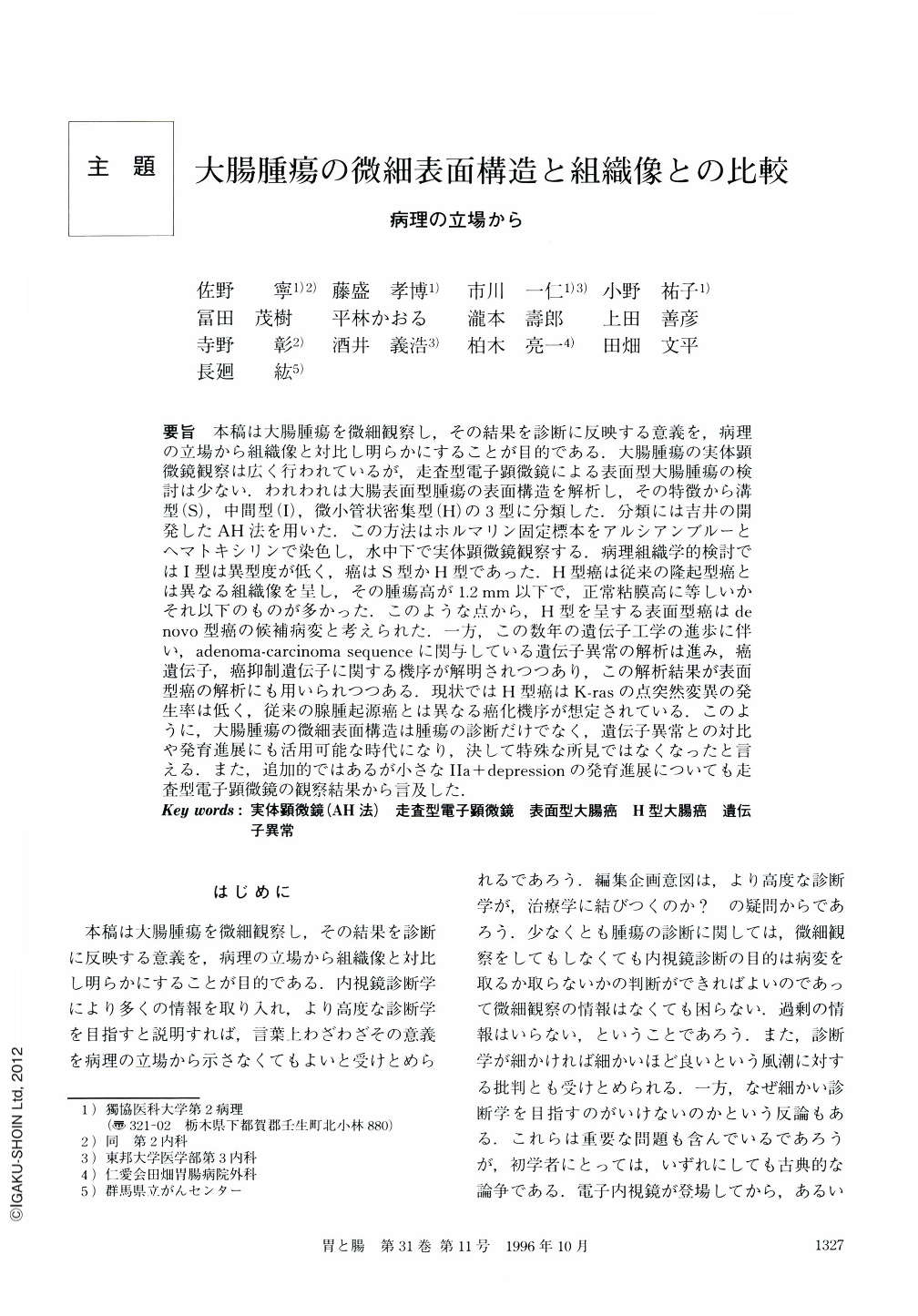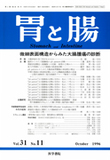Japanese
English
- 有料閲覧
- Abstract 文献概要
- 1ページ目 Look Inside
要旨 本稿は大腸腫瘍を微細観察し,その結果を診断に反映する意義を,病理の立場から組織像と対比し明らかにすることが目的である.大腸腫瘍の実体顕微鏡観察は広く行われているが,走査型電子顕微鏡による表面型大腸腫瘍の検討は少ない.われわれは大腸表面型腫瘍の表面構造を解析し,その特徴から溝型(S),中間型(I),微小管状密集型(H)の3型に分類した.分類には吉井の開発したAH法を用いた.この方法はホルマリン固定標本をアルシアンブルーとヘマトキシリンで染色し,水中下で実体顕微鏡観察する.病理組織学的検討ではⅠ型は異型度が低く,癌はS型かH型であった.H型癌は従来の隆起型癌とは異なる組織像を呈し,その腫瘍高が1.2mm以下で,正常粘膜高に等しいかそれ以下のものが多かった.このような点から,H型を呈する表面型癌はde novo型癌の候補病変と考えられた.一方,この数年の遺伝子工学の進歩に伴い,adenoma-carcinoma sequenceに関与している遺伝子異常の解析は進み,癌遺伝子,癌抑制遺伝子に関する機序が解明されつつあり,この解析結果が表面型癌の解析にも用いられつつある.現状ではH型癌はK-rasの点突然変異の発生率は低く,従来の腺腫起源癌とは異なる癌化機序が想定されている.このように,大腸腫瘍の微細表面構造は腫瘍の診断だけでなく,遺伝子異常との対比や発育進展にも活用可能な時代になり,決して特殊な所見ではなくなったと言える.また,追加的ではあるが小さなⅡa+depressionの発育進展についても走査型電子顕微鏡の観察結果から言及した.
Stereomicroscopic classification of colorectal tumor has been studied by many. However, little has been known about the scanning electron microscopical (SEM) characteristics of flat type colorectal tumor. We showed that the surface structures of colorectal tumor are classified into three types: sulcus type (S), intermediate type (I), and honeycomb-like type (H) . The Alcian-blue Hematoxyline (AH) method developed by Yoshii (1971, Stomach and Intestin) was used. Histologically H type carcinoma is different from S type and I type in the occurrence of budding growth.
Three dimensional observations by SEM clarified that the unitubular ducts grow horizontally in H type, on the other hand tubules grow vertically with budding in S and I type. While most of the elevated type tumor has S type surface structure, the flat and depressed type tumor have H or I type. I type tumor usually has low grade atypia, although H type has high grade atypia, and the height is not taller than that of the normal mucosa, which is about less than 1.2mm. On the other hand, the mucosal height of S type varies from nearly equal to more than twice of the normal mucosa.
Recently recongnition of the molecular analysis of colorectal tumor has advanced significantly, and in adenoma-carcinoma sequence, two of the most important events in the carcinogenesis are now recongnized to be the activation on the oncogene ras by point mutations and the loss of function on the suppressor gene p53. In flat type colorectal cancer which has H type surface structure, point mutation of ras oncogene is not involved. Furthermore it was shown that there is no significant difference between S and H type cancer in p53 abnormality. H type cancer might be a new cancer which develops via a different pathway from S or I type cancer, and might be a candidate of de novo carcinogenesis, although the suppressor gene p53 does not seem to play a role in determining the growth pattern of colorectal tumor.
In this report we also showed a new finding about the evolution of small adenoma using SEM, and proposed a new hypothesis on development of so-called Ⅱa + depression type adenoma. This type of adenoma cells surround the normal colonic cells, and expand over them. Morphologically, elongated and tubularly shaped crypt orifices can be seen among the normal colonic mucosa which shows round crypt orifice and is demarcated like the pentagon under SEM observation. We named this finding“pentagon appearance”. Histologically the two layer structure can be seen on the margin of this type of adenoma.
In conclusion, it is suggested that the observation of the surface structure of colorectal tumor by AH method and SEM is quite useful for connection with assessment of their nature, growth and progression.

Copyright © 1996, Igaku-Shoin Ltd. All rights reserved.


